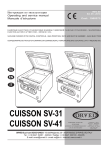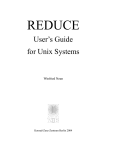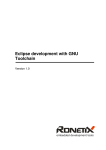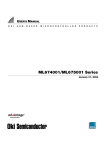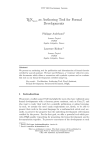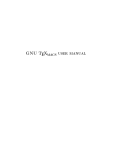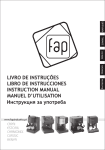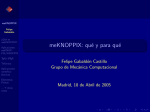Download free working environments for computer algebra - e
Transcript
Free Working Environments for Computer Algebra
Alkiviadis G. Akritas
ÓÄÊ 519.67
FREE WORKING ENVIRONMENTS
FOR COMPUTER ALGEBRA
Àííîòàöèÿ
 ñòàòüå ïðåäñòàâëåíû äâà ñâîáîäíî ðàñïðîñòðàíÿåìûõ ïàêåòà ñ îòêðûòûì èñõîäíûì êîäîì äëÿ èñïîëüçîâàíèÿ â êà÷åñòâå ñðåä äëÿ ðàáîòû ñ ñèñòåìàìè êîìïüþòåðíîé
àëãåáðû. Îíè ìîãóò èñïîëüçîâàòüñÿ êàê â ñðåäíåì, òàê è âûñøåì îáðàçîâàíèè, à òàêæå
ó÷åíûìè èç ðàçëè÷íûõ îáëàñòåé íàóêè.  ñòàòüå ïîêàçàíî ðåøåíèå äâóõ çàäà÷ â êàæäîé
è ñèñòåì, íà ïðèìåðå êîòîðûõ àíàëèçèðóþòñÿ ïðåèìóùåñòâà è íåäîñòàòêè ïðåäñòàâëåííûõ ñèñòåì.
Êëþ÷åâûå ñëîâà: ñèñòåìû êîìïüþòåðíîé àëãåáðû, CAS, Sage, TeXmacs.
1. INTRODUCTION
This year marks the 15th anniversary of the Journal «Computer Tools in Education». Over
these years a plethora of new computer tools has been developed for application in education and
research. Included in these tools is a number of free, open source CASs such as Sage, Sympy,
Xcas/Giac1 et al and several Text Editing Platforms with special scientific features such as LyX,
TeXmacs et al.
In this article two educational tools are presented as working environments for CASs: Sage, a
computer algebra system that can also serve as an editor, and TeXmacs, a scientific text editor that
can also serve as an interface for several computer algebra systems including Sage.
In the next section Sage is presented using TeXmacs as an interface. The main features of Sage
are highlighted with the help of two examples and its advantages / disadvantages are explicitly
stated at the end.
In the last section TeXmacs is presented as an interface to other CASs. Its main features are
highlighted with the help of the same set of examples used in the previous section, and its
advantages /disadvantages are also explicitly stated.
In both sections below, the «Output option» of TeXmacs Show timings has been enabled to
compare the execution times of the examples.2
Note that this article was entirely written in TeXmacs from which a LaTeX version was exported
for submission to the Journal.3
1 Xcas
is the interface for the Giac library.
examples in this paper were run on a Compac computer with Ubuntu 12.04 (precise) 32-bit and a Genuine Intel
CPU 585 at 2.16GHz.
3 Ïðè ïîäãîòîâêå ê ïå÷àòè ñòàòüÿ áûëà ñâ¸ðñòàíà çàíîâî â ïðèíÿòîé â æóðíàëå ñèñòåìå â¸ðñòêè ñòàòåé.
2All
© Alkiviadis G. Akritas, 2012
ÈÍÔÎÐÌÀÖÈÎÍÍÛÅ ÑÈÑÒÅÌÛ
35
Alkiviadis G. Akritas
2. SAGE
Sage was started by William Stein in 2004 but is now developed by a worldwide community
of contributors; it is a free, open-source CAS which integrates many specialized mathematics
software into a common interface, for which the user needs to know only the programming
language Python. However, Sage is not pure Python, since it makes use of many external packages
written in various other programming languages (C, C++, Fortran, Lisp, Python, etc); the list of
these packages can be seen at http://www.sagemath.org/linkscomponents.html.
Of interest to us is the fact that Sage comes bundled with four well established and time-tested
CASs: Gap, Maxima, Pari/Gp and Singular as well as the Python-based SymPy.1 This results in
two-fold benefits:
instead of writing functions anew, Sage uses the existing functions of these CASs: Gap for
Group Theory, Maxima for Calculus, Pari/Gp for Number Theory, Singular for Commutative
Algebra;
each one of these CASs can be used on its own; in this way, the user can verify the results
obtained in one system by comparing them against the results obtained using another.
Sage can be downlowded from http://www.sagemath.org/ and is available for Linux, MacOSX,
Solaris and Windows; the author found that Debian is the easiest package distribution system to
deal with. The user interface can be:
a Sage notebook in a web browser, in which case Sage connects either locally to ones own
Sage installation or to a Sage server on the network,
a command line in a terminal, and
TeXmacs, which is not mentioned neither in the Sage main web page nor in the Sage manuals/
tutorials.
Inside the Sage notebook or inside TeXmacs one can create embedded graphics, typeset
mathematical expressions, etc.
In the sequel, Sage is demonstrated by:
a) factoring the polynomial x2 9 in it, as well as in all the CASs that come bundled with it,
and
b) counting the number of prime numbers ≤ 100. TeXmacs is used as the interface and to start
the whole process we initiate an interactive session with Sage with the help of the menu Insert →
Session → Sage.2
After TeXmacs has been linked to Sage the following system information and Sage] prompt
appear indicating we are ready to begin; note that the red color of the prompt is the only difference
between the interface (original document) and the pdf file produced by LaTeX:
| Sage Version 5.5, Release Date: 2012-12-22
|
| Type ''notebook()'' for the browser-based notebook interface.
|
| Type ''help()'' for help.
|
Sage]
To factor x2 9 in Sage itself we first define the polynomial ring [x]:
Sage] R.<x> = ZZ['x']
and then enter the polynomial in the (already defined) variable x.
Sage] poly = x^2 - 9
31 msec
60 msec
1At the site https://github.com/sympy/sympy/wiki/SymPy-vs. Sage a comparison can be found between Sage and
SymPy.
2 It is assumed that Sage is installed on the computer and «visible» from a terminal window.
36
© ÊÎÌÏÜÞÒÅÐÍÛÅ ÈÍÑÒÐÓÌÅÍÒÛ Â ÎÁÐÀÇÎÂÀÍÈÈ. ¹ 6, 2012 ã.
Free Working Environments for Computer Algebra
The factors of x2 9 are obtained using the function factor() of Sage either in the classical
way:
Sage] factor(poly)
(x 3) ⋅ (x + 3)
689 msec
or in Python syntax:
Sage] poly.factor()
(x 3) ⋅ (x + 3)
11 msec
Obviously, since factor() was «imported» the first time it was used, it runs much faster the
second time.
As already mentioned, Sage is not «reinventing the wheel» but, when possible, uses functions
from the other free CASs. In this case, the Sage manual informs us that the function factor()
calls the corresponding function of the computer algebra system Pari/Gp. 1 Moreover, since we,
the users, also have direct access to all these CASs, we can factor the polynomial x2 9 using
directly the function factor() of Pari/Gp without first declaring the polynomial ring [x]:
Sage] pari( 'factor(x^2-9)' )
[x 3; 1; x + 3; 1]
134 msec
or in Python syntax:
Sage] f = gp.factor('x^2-9')
Sage] f
[x 3, 1; x + 3, 1]
520 msec
39 msec
In the above results, along with each factor we obtain its multiplicity, 1.
In the same spirit we can factor the polynomial x2 9 using the function factor() of
Maxima:
Sage] maxima( 'factor(x^2-9)' )
(x 3) (x + 3)
2.726 sec
or in Python syntax:
Sage] maxima.factor('x^2-9' )
(x 3) (x + 3)
To factor x2 9 in Singular we again first define the polynomial ring:
Sage] R = singular.ring(0, 'x' )
Sage] R
// characteristic
// number of vars
// block 1
//
// block 2
:
:
:
:
:
0
1
ordering lp
names x
ordering C
68 msec
749 msec
174 msec
1 In http://pari.math.u-bordeaux.fr we see that «Pari is a C library (C++ compatible), whereas Gp is an interactive
shell giving access to Pari functions, easier to use. Low-level scripts are typically 4 times slower than directly written C
code».
ÈÍÔÎÐÌÀÖÈÎÍÍÛÅ ÑÈÑÒÅÌÛ
37
Alkiviadis G. Akritas
and then enter the polynomial in the (already defined) variable x.
Sage] polyS = singular('x^2 - 9')
3 msec
The factors of x2 9 are obtained using the function factorize() of Singular either
through the library:
Sage] singular( ''factorize(x^2 - 9)'' )
[1]:
_[1]=1
_[2]=x+3
_[3]=x-3
[2]:
1,1,1
or in Python syntax:
Sage] polyS.factorize()
[1]:
_[1]=1
_[2]=x-3
_[3]=x+3
[2]:
1,1,1
13 msec
12 msec
Here again, the factors come with their multiplicities.
To factor the polynomial x2 9 in SymPy we have to import the function factor and the
variable x:
Sage] from sympy import factor
Sage] from sympy.abc import x
Sage] factor(x^2-9)
(x 3)*(x + 3)
3.394 sec
63 msec
37 msec
or in Python syntax:
Sage] (x^2-9).factor()
(x 3)*(x + 3)
63 msec
x2 9
Finally to factor the polynomial
in the computer algebra system Gap we have to first
define the polynomial ring (along with the variable) and then to take into consideration its special
interface with Sage as described in http://www.sagemath.org/doc/reference/sage/interfaces/
gap.html:
Sage] x = gap('Indeterminate(Integers,''x'')')
Sage] poly = gap.new(x^2-9)
Sage] poly.Factors()
[x 3; x + 3]
or
38
1.074 sec
76 msec
257 msec
© ÊÎÌÏÜÞÒÅÐÍÛÅ ÈÍÑÒÐÓÌÅÍÒÛ Â ÎÁÐÀÇÎÂÀÍÈÈ. ¹ 6, 2012 ã.
Free Working Environments for Computer Algebra
Sage] gap.Factors(poly)
[x 3; x + 3]
16 msec
Next, we address the second problem and write a small Sage program (actually a Sage for
loop) to count the number of prime numbers ≤ 100. Sage, of course, does have the functions
prime_pi() and is_prime() that could be used, but we avoid them in order to demonstrate
both the advantages and disadvantages of Sage. Instead, we use the function IsPrime() of Gap
inside the Sage for loop.
To know what to expect, though, we first compute the answer directly using the function
primepi() of Pari/Gp:
Sage] pari( 'primepi(100)' )
25
or in Python syntax:
Sage] gp.primepi(100)
25
11 msec
13 msec
So, there are 25 prime numbers ≤ 100. And below is the same answer using the Sage for loop
with the computer algebra system Gap:
Sage] counter = gap(0)
Sage] for i in range(100):
if gap(i+1).IsPrime():
counter = counter + 1
Sage] counter
25
1.6 sec
671 msec
463 msec
Note that although Maxima does have the function primep(), to test if an integer is a prime
number, the system cannot be used in the for loop above because in http://www.sagemath.org/doc/
reference/sage/interfaces/maxima.html it is stated that «Maxima does not seem to have a noninteractive mode which is needed for Sage». So, the viable candidates for use inside the Sage for
loop are Gap and Pari/Gp, where in the latter isprime() tests an integer for primality.
From the above examples one can easily draw the following conclusions regarding the
advantages and disadvantages of Sage:
Advantages: The main advantage of Sage is the ability to use the various CASs packaged
with it by learning just one general purpose language, Python! Moreover, Sage can connect to
optional CASs, like Magma, Maple and Mathematica (all commercial), and Giac (free).
Also, another advantage is the ease with which one can get the archive of files (tarball) and
compile all the packages simultaneously, as opposed to finding and compiling packages individually.
Disadvantages: Obviously it is quite impressive to be able to call different packages in the
same program; by integrating these packages into a common (Python) interface Sage gets a lot of
functionality without having to «reinvent the wheel». However, this very interface can also be a
bane as in the case of Maxima not been able to run the Sage for loop above. Moreover, due to this
interface at times it is impossible to take advantage of the very efficient and fast routines that exist
in some libraries. To wit:
Consider the (C++) library LinBox, which is one of the packages loaded with Sage and where
there is an e cient implementation of large integer determinants that can be called from Sage.
However, if Sage needs to call Maxima (to compute, say, the antiderivative of a function), and
ÈÍÔÎÐÌÀÖÈÎÍÍÛÅ ÑÈÑÒÅÌÛ
39
Alkiviadis G. Akritas
during this computation Maxima needs to compute a large determinant, then Maxima will never
be able to call that efficient implementation in LinBox!1
Finally, regarding Sage installations on Windows, it is worth mentioning that there is no
Windows port; instead, Sage provides a VirtualBox that you can run from Windows an arrangement
that requires a lot of memory. This is no problem if you have a powerful PC, however, Sage will
probably not be able to run on most Windows netbooks or older PCs | since a precompiled version
of Sage works on a linux netbook.
3. TEXMACS
TeXmacs is a free wysiwyw (what you see is what you want) editing platform with special
features for scientists. It was designed and written by Joris van der Hoeven, who was inspired both
by the TeX system, written by D. Knuth, and by Emacs, written by R. Stallman; hence the name
TeXmacs. Today it is supported by a worldwide team of contributors and is available for Knoppix,
Linux, MacOSX and Windows; for more details see http://www.texmacs.org.
The software aims to provide a unified and user friendly framework for editing structured
documents with different types of content (text, graphics, mathematics, interactive content, etc.).
The rendering engine uses high-quality typesetting algorithms and produces professionally looking
documents.
Included in the software is a a text editor with support for mathematical formulas, a small
technical picture editor and a tool for making presentations from a laptop. New features can be
added to the editor using the Scheme extension language.
Of interest to us is the fact that TeXmacs can be used as an interface for among others
several external CASs like Maxima, Pari/Gp, Sage, Xcas/Giac et al. The complete list of packages
that can be plugged into TeXmacs can be seen in http://www.texmacs.org.
In this section we use TeXmacs as an interface to the computer algebra systems Maxima, Pari/
Gp, Sage and Xcas/Giac,2 and we solve both problems of the previous section; that is, we: (a)
factor the polynomial x2 9 in each system, and (b) count the number of primes ≤ 100, by writing
a for loop in the language of each system. This way we are able to draw our own conclusions
regarding TeXmacs advantages and disadvantages.
We begin by initiating a session with Maxima. To save space, the system information that
appears after linking TeXmacs with Maxima is not included; and the same is true for subsequent
CASs in this section.
The factorization is easily performed:
(%i1) factor(x^2-9)
(%o1) (x 3)(x + 3)
54 msec
and so is the counting of the prime numbers ≤ 100 with the following for loop:
(%i2) counter : 0
(%o2) 0
(%i3) for i:1 thru 100 do
if primep(i) then counter : counter + 1
(%o3) done
18 msec
76 msec
1 For that, it is required to glue the C libraries at the C level, not at the Python level, or everything must be
implemented at the Python level something Sympy is trying to do. But even then, Python was not designed to be an
efficient language for computer algebra systems.
2 All assumed installed on the computer and «visible» from a terminal window.
40
© ÊÎÌÏÜÞÒÅÐÍÛÅ ÈÍÑÒÐÓÌÅÍÒÛ Â ÎÁÐÀÇÎÂÀÍÈÈ. ¹ 6, 2012 ã.
Free Working Environments for Computer Algebra
(%i4) counter
(%o4) 25
17 msec
Obviously, when Maxima is called directly by TeXmacs, and not through Sage, the for loop is
executed without any problems and we obtain the correct answer.
Next we initiate a session with Pari. Again, the factorization is easily done:
Pari] factor(x^2-9)
x − 3 1
x + 3 1
%1 =
and so is the for loop to count the prime numbers ≤ 100:
Pari] counter = 0
%2 = 0
Pari] for(i=1,100,
if( isprime(i), counter = counter + 1 )
)
Pari] counter
%3 = 25
80 msec
12 msec
54 msec
11 msec
Out of curiosity, we initiate a session with Sage and, through it, we call Pari/Gp to perform the
same for loop and compare times:
Sage] counter = pari(0)
73 msec
Sage] for i in range(100):
if pari(i+1).isprime():
counter = counter + 1
356 msec
Sage] counter
25
74 msec
Clearly, Sages interface slows things down quite a bit.
Finally, we initiate a session with Giac. Here again the factorization is as was in the previous
CASs:
> factor(x^2-9)
(x 3)(x + 3)
92 msec
and the prime numbers ≤ 100 are counted in about the same way using the function isprime():
> counter:=0
0
> for (j:=1;j<=100;j++) {
if (isprime(j)) {counter := counter + 1}
}
0
> counter
ÈÍÔÎÐÌÀÖÈÎÍÍÛÅ ÑÈÑÒÅÌÛ
25
58 msec
83 msec
83 msec
41
Alkiviadis G. Akritas
Xcas/Giac also known as the «Swiss knife for Mathematics» is a powerful CAS (combined
with programming, interactive 2-d and 3-d geometry and a spreadsheet) that is under active
development by Bernard Parisse and supported by a worldwide community of contributors. Besides
its ability to link to TeXmacs, Xcas/Giac can also link to the computer algebra systems CoCoA
and Pari as well as to several other free, open source libraries, utilizing all the efficient and fast
routines that are available.1
Giac is linked with Pari through the command pari(), which makes available to Giac all the
functions of the Pari library provided they are prefixed by pari . So we can have:
> pari()
55 msec
> pari_factor(x^2-9)
x − 3 1
x + 3 1
85 msec
From the above examples we can easily draw the following conclusions regarding the advantages
and disadvantages of TeXmacs:
Advantages: A first advantage of TeXmacs is that it offers a wider choice of CASs to use than
Sage; namely, it offers most of the packages that come bundled in Sage, Sage itself plus additional
ones listed in http://www.texmacs.org that are not bundled in Sage. The fact that these CASs
have to be installed separately is not a problem at all for package distribution systems like Debian/
Ubuntu.
Secondly, the interface of TeXmacs with each individual CAS is direct and not prone to problems
that arise using Sages interface as for example Sages interface with Maxima that we saw in the
previous section.
Finally, if the user already has experience with a certain CAS, then s/he can go on and use it
right away with TeXmacs as an interface, without having to worry about learning Python first.
Disadvantages: The only disadvantage that one might attribute to TeXmacs is the fact that
one cannot use it as an editor for the Greek language; however, Greek letters are available in math
mode. Hopefully, this situation will be remedied in the future.
4. CONCLUSIONS
From the previous discussion it is obvious that for the packages discussed in this paper we
have the following «dependencies»:
Therefore, if your favorite CAS has a TeXmacs plug-in and you need a powerful editor, then
TeXmacs is the interface to use. It is worth noting that after TeXmacs session with the corresponding
CAS has been initiated, along with the system information there appear instructions on how to
1 That
42
is, unlike Sage, Giac glues the C libraries at the C level.
© ÊÎÌÏÜÞÒÅÐÍÛÅ ÈÍÑÒÐÓÌÅÍÒÛ Â ÎÁÐÀÇÎÂÀÍÈÈ. ¹ 6, 2012 ã.
Free Working Environments for Computer Algebra
open the CASs manuals and tutorials in case you need them. The only exception is Maxima where
only the system information appears; however, simultaneously, a big question mark appears
without any warning | at the right end of the menu bar and it is by pressing this question mark that
the users manual opens up.1
The choice of the CAS itself depends on the users needs. The argument in favor of Sage is
that by learning one programming language, Python, the user can utilize several CASs, whereas to
program in the other CASs the user has to learn one programming language for each one of them.
However, as we saw in the examples of the previous section, the syntaxes of all these languages
are related, and it is not hard to switch from one to the other. Moreover, like with natural languages,
when circumstances demand it one easily becomes a «polyglot»!
1 For more details see «A tutorial on the Maxima plug-in» by Andrey Grozin, which can be found in http://
www.texmacs.org; strongly recommended.
Abstract
Two free, open-source packages are presented for use as working environments for
Computer Algebra Systems (CASs). They can be used in Secondary and Higher Education as
well as by scientists in various fields. In this paper a set of two problems is solved in both
systems revealing their advantages and disadvantages.
Keywords: Computer Algebra Systems, CAS, Sage, TeXmacs.
Alkiviadis G. Akritas,
University of Thessaly
Dept. of Communication and Computer
Engineering, Volos Greece,
[email protected]
ÈÍÔÎÐÌÀÖÈÎÍÍÛÅ ÑÈÑÒÅÌÛ
43









